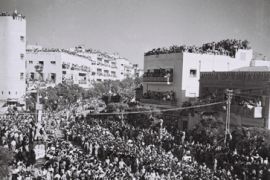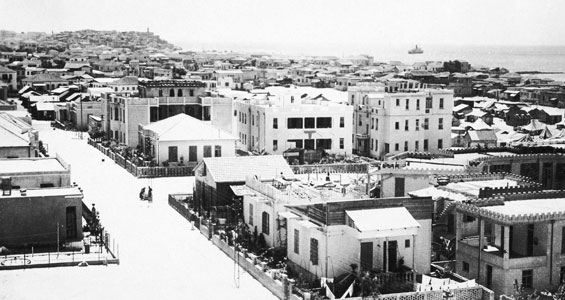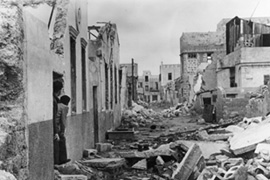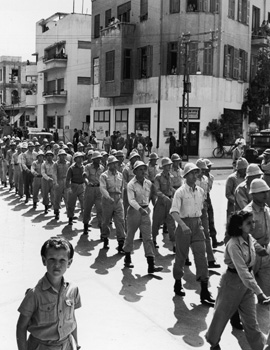Framing Tel Aviv
Historian says film festival fails to challenge the Israeli city’s imagined identity.

 |
| Jaffa in 1929, before the creation of the state of Israel [GALLO/GETTY] |
It is not surprising that the organisers of the Toronto International Film Festival (TIFF)chose to turn a spotlight on Tel Aviv this year, the city’s centennial.
The city has featured prominently in many important Israeli films, and is home to what has become the archetypical Israeli identity: modern, hip, liberal and even progressive.
Keep reading
list of 4 itemsFire engulfs iconic stock exchange building in Denmark’s Copenhagen
Inside the pressures facing Quebec’s billion-dollar maple syrup industry
‘Accepted in both [worlds]’: Indonesia’s Chinese Muslims prepare for Eid
But a great film festival, like great art more broadly, is not supposed to uncritically mirror uncritical depictions of subjects and spaces.
Rather, it is supposed to sponsor films that interrogate the most basic perceptions of reality, particularly when that reality is grounded in intense and long-term conflicts, in which various narratives of what is the ‘true’ history and present circumstances are in contrast.
By turning a spotlight on Tel Aviv, the festival intervened in an ongoing and deeply divisive conflict. Organisers had a responsibility to ensure that their intervention would encourage soul-searching and the search for a more accurate representation of the city’s, and country’s, past and present.
In framing the choice of Tel Aviv, the festival’s co-director described the city as a “young, dynamic city that, like Toronto, celebrates its diversity”.
The reality is that to the extent the city celebrates its diversity, it has done so largely by marginalising the city’s Palestinian Arab heritage and present-day citizens.
Exclusion and erasure
In 1909, Tel Aviv’s founders sought to create a space that was “modern, Jewish … [and] European” and prohibited the sale of property to non-Jews.
| in depth | |||||||
|
Tel Aviv was depicted in Zionist poetry, art, journalism and literature as having emerged like a “reed inserted into a sea of sand”; any connection to Jaffa and the surrounding Arab environment was ignored.
So powerful has this imagery of being born “out of the sands” remained that when it celebrated Israel’s 50th anniversary, the Economist described Tel Aviv as “having hardly any Arabs … it was built by Jews, for Jews, on top of sand dunes, not on top of anybody else’s home”.
The reality was quite different. While founded on a sandy region near the sea shore, Tel Aviv was deeply connected to Jaffa, which had its own, growing Jewish community that had reached over 30,000 by the 1940s.
The new neighbourhood was also part of a complex ecosystem that included citrus orchards and farms, Jaffa and its famous port, mills, bedouin encampments, and six Palestinian villages.
The remnants of one village, Summel, are still visible along Ibn Givrol Street, not far from where Yitzhak Rabin, the former Israeli prime minister, was murdered. The former home of the sheikh of the Palestinian village of Sheikh Muwannis has long been used as the faculty club of Tel Aviv University.
Adversarial, not neighbourly
Despite the many connections between the Jewish town and its Palestinian surroundings, Tel Aviv’s leaders directed the town’s development largely as if Jaffa was an adversary rather than a neighbour.
 |
| Violence sometimes erupted along the border between Tel Aviv and Jaffa [GALLO/GETTY] |
Nevertheless, the two towns’ development mirrored each other in many ways both in terms of architecture and town planning.
Yet when Unesco designated Tel Aviv a World Heritage Site last year because of its large number of buildings constructed in the International Style, it completely excluded Jaffa from its celebration.
In reality, Jaffa is home to some of the best examples of the style in the country.
It is precisely the prevalence of the myth of Tel Aviv standing utterly apart and unique from Jaffa – hyper-modern and cybaritic versus traditional, clean versus dirty, secular and progressive versus religious and backwards – that obligated the organisers of the festival to offer a more accurate depiction of the history.
History of violence
Despite its image of diversity and vibrancy, Tel Aviv has long been a site of significant intercommunal violence. The first major Jewish-Palestinian riots erupted along the border between the two towns in 1921, as did the Arab Revolt of 1936-39.
Crucial for the situation in the Occupied Territories today, during this period Tel Aviv’s leadership developed strategies for gaining control over Palestinian land.
They created new administrative boundaries, using town planning and architecture to separate communities and further weaken Palestinians’ hold on the land, that are now staples of Israeli policies across the Green Line.
In the four decades after 1948, when 70,000 Palestinian Arabs were forced to flee Jaffa and not allowed to return, the once grand town became a backwater, while Tel Aviv grew into one of the premiere ‘world cities’.
In the 1980s, Jaffa was rediscovered as a funky and authentic place to live, and a process of gentrification began that has seen much of the remaining Palestinian Arab population priced out of their homes through a combination of state policy and market forces.
Art challenging reality
It must be pointed out that the organisers of the Toronto International Film Festival have not avoided films that depict the less pleasant aspects of life in contemporary Tel Aviv, as there are at least two films which depict life in Jaffa in a less than celebratory manner.
But exhibiting films that offer particular challenges to the larger identity do not relieve a curator of responsibility for ensuring that that identity is fully interrogated and not uncritically rehearsed.
In this sense, it is not surprising that Cameron Bailey, the programme director for City to City, defended his framing and choice of subjects by arguing that it was “curated entirely independently. There was no pressure from any outside source”.
There does not need to be outside pressure, so well-established is the image of Tel Aviv that, unlike Israel’s actions in the Occupied Territories, it rarely if ever needs to be defended.
In fact, the image is so well-worn that even the inclusion of two fine critical films about Jaffa, Keren Yedaya’s Jaffa and Scandar Copti and Yaron Shani’s Ajami, that challenge many of the assumptions underlying the City to City narrative, did not cause festival organisers to question the way Tel Aviv was being portrayed more broadly, or whether it should be celebrated.
Most importantly, in focusing on the grittiness of life in Tel Aviv’s ‘Arab neighbourhood’ without any larger historical or political context, such films, however fine and perceptive they are on their own merits, can be used to reinforce the erasure of Jaffa’s modern heritage, the negative stereotypes about contemporary Jaffa (and Palestinians more broadly), and allow the role of the Israeli state in fomenting and sustaining many of the conflicts and problems they depict to remain in the background, uninterrogated.
The inclusion of these films also serves to reinforce the self-congratulating image of Israel as tolerant and self-critical.
The image of Tel Aviv remains worthy of celebration, warts and all, precisely because its role in the project of Zionist “colonisation” – as the movement’s leaders openly described it – of Palestine, and to Israeli state policies of “Judaisation” – to use Ariel Sharon’s terminology – on both sides of the Green Line, are left outside the frame.
Consequences of boycott
Whether or not one supports the proposed boycott, those who have called for it have laudably forced those behind the festival and those who will attend it to grapple with issues that would otherwise have been left, as it were, on the cutting room floor.
And the filmmakers behind Jaffa and Ajami could use the controversy to make a more sustained critique of Tel Aviv and Israeli policies at the festival than would have otherwise been possible.
Indeed, leading Arab intellectuals like Elias Khoury oppose cultural boycotts in favour of using gatherings like the Toronto Festival to aggressively challenge Israel’s image and myths.
Yet however opportunistically artists or activists might respond, festival organisers still had the responsibility to be critically engaged enough to use Tel Aviv’s centennial to shape a much more sober and accurate, if uncelebratory, portrait of the city.
They could have brought not just critical Israelis but Palestinians from both sides of the Green Line, who have for so long been excluded from Tel Aviv’s imagined identity, to confront that image with narratives that would force all of us to consider what it means for a city’s self-image and its actual history and present personality to be so overwhelmingly at odds.
 |
| Irgun members march through Tel Aviv on the eve of Israel’s creation [GALLO/GETTY] |
Perhaps then festival-goers might have come to a better understanding of why it remains so difficult to achieve a final peace between the two peoples despite the fact that everyone seems to know what the contours of such an agreement must be.
Instead, in framing their presentation, festival organisers chose to continue the century-long pattern of ignoring Tel Aviv’s Palestinian past, present and ultimately future.
In so doing, however, they not only tarnished its critical impact but have given its intellectual and artistic imprimatur to the continued marginalisation, or at best ghettoisation, of Palestinians from aesthetic depictions and discussions of the most important issues facing their shared homeland.
Equally sad, the festival narrative of Tel Aviv will make it harder for attendees to begin the much-needed conversations – within themselves as much as with others – about why Israel is rushing headlong into a future of full-blown apartheid that other former settler colonial societies have worked hard to escape.
As long as the festival refuses to engage these hard issues, artists of good faith should not feel guilty if they choose to join their colleagues from Israel, Palestine, and around the world, who have refused to participate in the festival.
And those who attend have a responsibility not merely to ensure that a very teachable moment does not pass by unexploited, but to help ensure that the next festival that focuses on a conflict-ridden city or country creates a much stronger intellectual and aesthetic foundation for its programming.
Mark Levine is a professor of history at the University of California, Irvine and author, most recently, of Heavy Metal Islam: Rock, Resistance, and the Struggle for the Soul of Islam (Random House 2008) and Impossible Peace: Israel/Palestine Since 1989 (Zed Books, 2009). He lived in Tel Aviv for a number of years in the 1990s.
The views expressed in this article are the author’s own and do not necessarily reflect Al Jazeera’s editorial policy.
